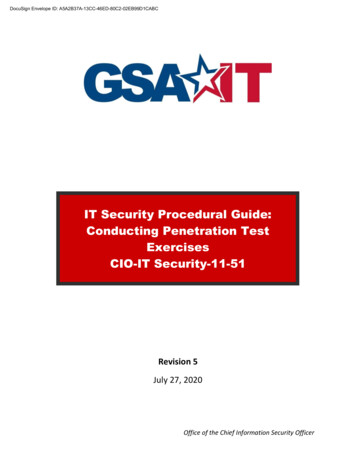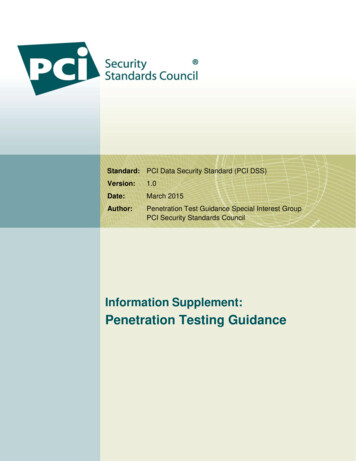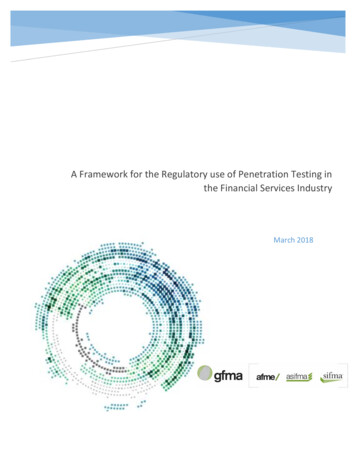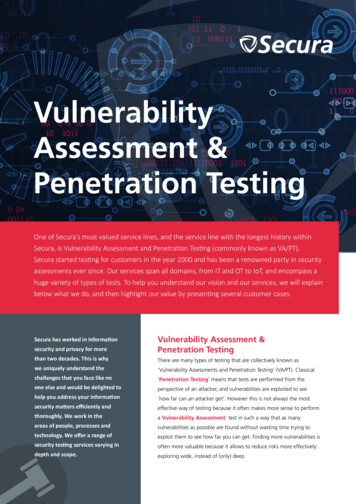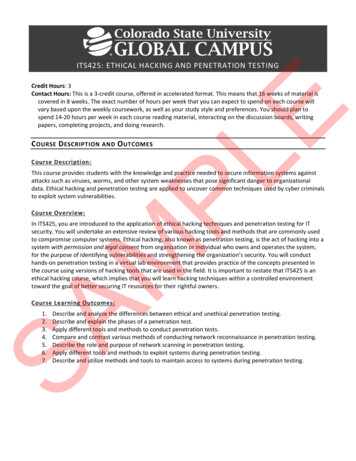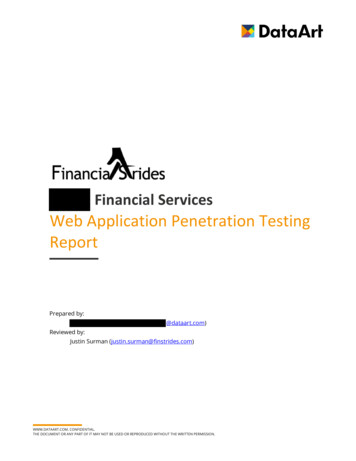
Transcription
Financial ServicesWeb Application Penetration TestingReportPrepared by:@dataart.com)Reviewed by:Justin Surman (justin.surman@finstrides.com)WWW.DATAART.COM. CONFIDENTIAL.THE DOCUMENT OR ANY PART OF IT MAY NOT BE USED OR REPRODUCED WITHOUT THE WRITTEN PERMISSION.
Version: 1.7Date: 03/31/2020ConfidentialContentsExecutive Summary . 4Issues Remediation . 6Assessment Methodology . 7Automated Application Scan . 7Manual Application Testing. 7Criteria for Risk Ratings . 8Assessment Findings . 10Summary . 10High Risk Findings . 11Medium Risk Findings . 11M1. Enumeration of registered emails . 11M2. Persistent cookie with sensitive information . 13M3. Sensitive cookies without the ”Secure” flag . 15M4. The password reset link is reusable . 18M5. The application is vulnerable to brute-force attacks . 20Low Risk Findings . 24L1. Strict-Transport-Security header is not used. 24L2. Cross-domain policy misconfiguration . 26L3. Auto-complete feature is not disabled for password fields . 28L4. The application server supports TLS cipher suites without forward security . 30Conclusion . 32WWW.DATAART.COM. CONFIDENTIAL.THE DOCUMENT OR ANY PART OF IT MAY NOT BE USED OR REPRODUCED WITHOUT THE WRITTEN PERMISSION.3
Version: 1.7Date: 03/31/2020ConfidentialExecutive SummaryFinancial Strides engaged DataArt to perform a penetration testing of theweb application. Theprimary goal of this web application (Grey box) penetration testing project was to identify any potential areasof concern associated with the application in its current state and determine the extent to which the systemmay be breached by an attacker possessing a particular skill and motivation. The assessment was performedin accordance with the “best-in-class” practices as defined by ISECOM's Open Source Security TestingMethodology Manual (OSSTMM), Open Web Application Security Project (OWASP) and Penetration TestGuidance for PCI DSS Standard.DataArt conducted the penetration testing during the period of March 12 – 18, 2020. All testing activitieswere performed on the staging environment provided by the customer and completely isolated from theproduction data. While performing the testing activities, DataArt emulated an external attacker without priorknowledge of the environment. To test the user-authenticated area and privilege escalation vulnerabilities,the customer supplied DataArt credentials for several registered user and admin accounts.The scope of the assessment included the following: https://app-staging https://api-stagingcom/ - (Consumer Facing Web App - public and authenticated areas);com/ - (Django, Admin facing WebApp andweb API);Notes: It should be noted, that the Dashboard - Panel “Account Profile” functionality offered by theConsumer Facing Web App was not available during the penetration test and was excluded from thescope of the current assessment. The staging web application environment provided byfor the application penetration testingutilized partner stub & sandbox integrated environments only (Plaid /).During the course of this assessment, DataArt did not identify any critical vulnerabilities that could lead tofull compromise of the system. However, DataArt did find several medium and low severity issues, whichshould be addressed byAs of 03/31/2020, thedevelopment team has fixed all of the discovered medium vulnerabilities.Further detailed information can be found in the “Issues Remediation” section of this report.DataArt strongly recommendsto remediate all medium severity issues detected to mitigate againstthe possible risk of a sensitive data compromise. The remediation of the low severity findings is not so urgentdue to the low probability of their successful exploitation. Nonetheless, it should be noted that the existenceof these known issues could decrease the overall security posture of the system.This report summarizes what DataArt believes are the most important issues to address in the application.The chart below outlines a number of issues identified that are grouped by risk factors. Note the risk ratingsWWW.DATAART.COM. CONFIDENTIAL.THE DOCUMENT OR ANY PART OF IT MAY NOT BE USED OR REPRODUCED WITHOUT THE WRITTEN PERMISSION.4
Version: 1.7Date: 03/31/2020ConfidentialIssues RemediationDataArt re-verified all previously found issues on March 26, 2020. The tested application was accessible bythe same URLs used during the initial testing.As of 03/26/2020, the following issues were successfully remediated: M1. Enumeration of registered emails M3. Sensitive cookies without the ”Secure” flag M4. The password reset link is reusable M5. The application is vulnerable to brute-force attacks L2. Cross-domain policy misconfigurationA subsequent re-test was performed on March 31,2020. As of 03/31/2020 the following issue wassuccessfully remediated: M2. Persistent cookie with sensitive informationThe other issues (L1, L3, L4) are still actual.WWW.DATAART.COM. CONFIDENTIAL.THE DOCUMENT OR ANY PART OF IT MAY NOT BE USED OR REPRODUCED WITHOUT THE WRITTEN PERMISSION.6
Version: 1.7Date: 03/31/2020ConfidentialAssessment MethodologyDataArt based the findings and recommendations, outlined in this report, on application vulnerability scansand manual penetration testing performed against the application.Automated Application ScanDataArt used several commercial tools to survey the targeted environment and identify potentialvulnerabilities. The automated scanning software identifies application-level vulnerabilities. The scope oftesting includes but not limited by the following: Parameter Injection SQL Injection Cross-Site Scripting Directory Traversal Parameter Overflow Buffer Overflow Parameter Addition Path Manipulation Character Encoding Site Search SSL Strength Sensitive Developer Comments Web Server/Web Package Identification Permissions Assessment Brute Force Authentication attacksManual Application TestingUsing the information produced by the automated testing software, DataArt also employed manual testingtechniques to identify and attempt exploiting additional vulnerabilities in the targeted application, and toeliminate false positives produced by the automated scanning process. The assessment was conducted inaccordance with the best-in-class practices as defined by such methodologies as ISECOM's Open SourceSecurity Testing Methodology Manual (OSSTMM) and the Open Web Application Security Project (OWASP).DataArt performed the following actions as part of this testing: Gathered information about the application Mapped application content and analyzed it Observed types and placement of security controls Reviewed web page HTML source code for possible vulnerabilitiesWWW.DATAART.COM. CONFIDENTIAL.THE DOCUMENT OR ANY PART OF IT MAY NOT BE USED OR REPRODUCED WITHOUT THE WRITTEN PERMISSION.7
Version: 1.7Date: 03/31/2020ConfidentialRecommendationsThe application should instruct web browsers to only access the application using encrypted HTTPS channel.For that, HTTP Strict Transport Security (HSTS) should be enabled by adding a response header with thename 'Strict-Transport-Security' and the value 'max-age expireTime', where expireTime is the time inseconds that browsers should remember that the site should only be accessed using HTTPS.To apply the policy to all subdomains, the 'includeSubDomains' flag could be also utilized. As an additionalsecurity measure the domain should be submitted to an HSTS preload service.The detailed information can be found via the following links below: ter/cheatsheets/HTTP Strict Transport Security Cheat Sheet.md https://hstspreload.org/?domain api-staging https://hstspreload.org/?domain app-stagingcomcomDue to the fact that the affected applications utilize Amazon CloudFront as the CDN system for deliveringstatic content, there is no direct way to set the required server header. However, as a workaround solution,it is possible to introduce an intermediate Edge Lambda function which puts the appropriate headers ontoCloudFront HTTP responses before they're sent to the clients, see reference links below. (Note: however,such a configuration introduces an extra point of failure and could affect performance and availability of thesite): ers-to-s3-websites-2002f243aa8f -s3-host-website https://adamj.eu/tech/2019/04/15/scoring-a icwebsite/As a possible way of remediation for the Django CMS used by one of the applications (https://apistagingcom/admin), it is recommended to set appropriate security parameters within Django smiddleware as it is described in the article below: re/#http-strict-transport-securityRemediationAs of 03/26/2020, the issue was not remediated. Applications still do not utilize the “Strict-TransportSecurity” header for encrypted communication:WWW.DATAART.COM. CONFIDENTIAL.THE DOCUMENT OR ANY PART OF IT MAY NOT BE USED OR REPRODUCED WITHOUT THE WRITTEN PERMISSION.25
Version: 1.7Date: 03/31/2020ConfidentialRecommendationsThe password autocomplete should always be disabled, especially in sensitive applications, since an attacker,if able to access the browser cache, could easily obtain the password in clear-text.The detailed information about autocomplete implementation in all modern browsers can be found in thesearticles below: ty/Securing your site/Turning off form autocompletion ty/Securing your site/Turning off form autocompletion#Tools for disablingautocompletion ttributes/autocomplete#Browser compatibilityRemediationAs of 03/26/2020, the issue was not remediated. The password autocomplete is still enabled for thepassword fields.L4. The application server supports TLS cipher suites without forward securityRisk Rating: LOWRemediation Efforts: LOWSummaryDataArt noticed that the application servers supported TLS cipher modes that used RSA encryption for keyexchange. Though the encryption algorithm was considered secure, it did not provide Forward Secrecy (FS).It also could potentially lead to a private key compromise in the presence of such vulnerabilities asBleichenbacher’s Oracle or ROBOT or other yet unknown vulnerabilities.Affected FunctionalityThe issue affected all cipher suites except the ECDHE ones allowed by the application servers: app-staging api-stagingcom (443/TCP);com -SHA256Proof of ConceptThe images below show all cipher suites allowed by the application servers. The weak ones are markedred:WWW.DATAART.COM. CONFIDENTIAL.THE DOCUMENT OR ANY PART OF IT MAY NOT BE USED OR REPRODUCED WITHOUT THE WRITTEN PERMISSION.30
Version: 1.7Date: 03/31/2020ConfidentialConclusionDataArt completed the penetration testing of theweb application. This testing was based on thetechnologies and known threats as of the date of this document. All the security issues discovered duringthat exercise were analyzed and described in this report.Please note that as technologies and risks change over time, the vulnerabilities associated with the operationof systems described in this report, as well as the actions necessary to reduce the exposure to suchvulnerabilities, will also change.WWW.DATAART.COM. CONFIDENTIAL.THE DOCUMENT OR ANY PART OF IT MAY NOT BE USED OR REPRODUCED WITHOUT THE WRITTEN PERMISSION.32
DataArt conducted the penetration testing during the period of March 12 – 18, 2020. All testing activities were performed on the staging environment provided by the customer and completely isolated from the production data. While performing the testing activit ies, DataArt emulated an exte


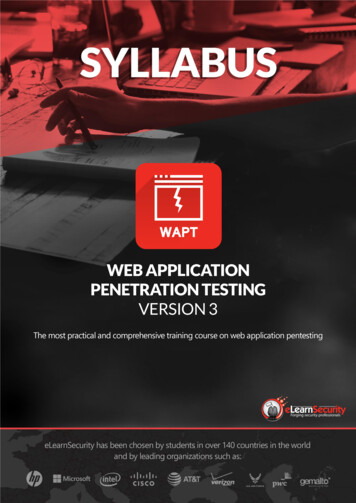


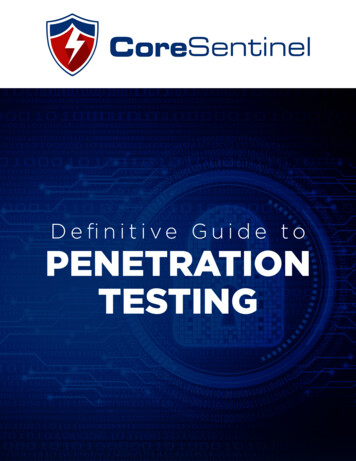
![[Anonymized] Web application penetration testing report](/img/22/anonymized-web-application-penetration-testing-report.jpg)
